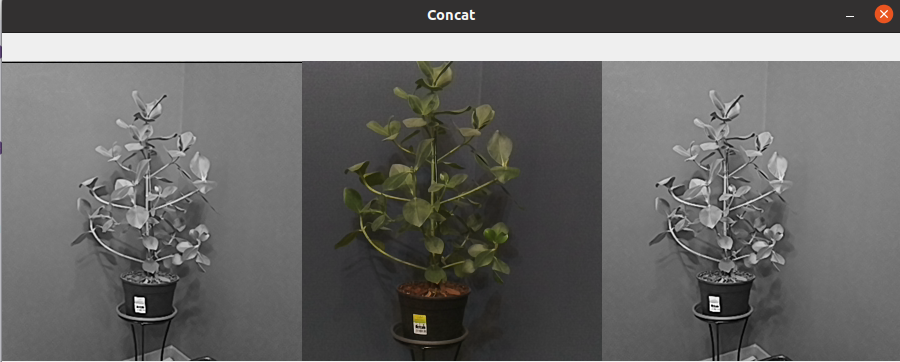Multi-Input Frame Concatenation
Example concatenates all 3 inputs with a simple custom model created with PyTorch (link here, tutorial here). It uses NeuralNetwork's multiple input feature and links all 3 camera streams directly to the NeuralNetwork node.Demo

Setup
Please run the install script to download all required dependencies. Please note that this script must be ran from git context, so you have to download the depthai-python repository first and then run the scriptCommand Line
1git clone https://github.com/luxonis/depthai-python.git
2cd depthai-python/examples
3python3 install_requirements.pySource code
Python
C++
Python
PythonGitHub
1#!/usr/bin/env python3
2
3from pathlib import Path
4import sys
5import numpy as np
6import cv2
7import depthai as dai
8SHAPE = 300
9
10# Get argument first
11nnPath = str((Path(__file__).parent / Path('../models/concat_openvino_2021.4_6shave.blob')).resolve().absolute())
12if len(sys.argv) > 1:
13 nnPath = sys.argv[1]
14
15if not Path(nnPath).exists():
16 import sys
17 raise FileNotFoundError(f'Required file/s not found, please run "{sys.executable} install_requirements.py"')
18
19p = dai.Pipeline()
20p.setOpenVINOVersion(dai.OpenVINO.VERSION_2021_4)
21
22camRgb = p.createColorCamera()
23camRgb.setPreviewSize(SHAPE, SHAPE)
24camRgb.setInterleaved(False)
25camRgb.setColorOrder(dai.ColorCameraProperties.ColorOrder.BGR)
26
27def create_mono(p, socket):
28 mono = p.create(dai.node.MonoCamera)
29 mono.setBoardSocket(socket)
30 mono.setResolution(dai.MonoCameraProperties.SensorResolution.THE_400_P)
31
32 # ImageManip for cropping (face detection NN requires input image of 300x300) and to change frame type
33 manip = p.create(dai.node.ImageManip)
34 manip.initialConfig.setResize(300, 300)
35 manip.initialConfig.setFrameType(dai.RawImgFrame.Type.BGR888p)
36 mono.out.link(manip.inputImage)
37 return manip.out
38
39# NN that detects faces in the image
40nn = p.createNeuralNetwork()
41nn.setBlobPath(nnPath)
42nn.setNumInferenceThreads(2)
43
44camRgb.preview.link(nn.inputs['img2'])
45create_mono(p, dai.CameraBoardSocket.CAM_B).link(nn.inputs['img1'])
46create_mono(p, dai.CameraBoardSocket.CAM_C).link(nn.inputs['img3'])
47
48# Send bouding box from the NN to the host via XLink
49nn_xout = p.createXLinkOut()
50nn_xout.setStreamName("nn")
51nn.out.link(nn_xout.input)
52
53# Pipeline is defined, now we can connect to the device
54with dai.Device(p) as device:
55 qNn = device.getOutputQueue(name="nn", maxSize=4, blocking=False)
56 shape = (3, SHAPE, SHAPE * 3)
57
58 while True:
59 inNn = np.array(qNn.get().getFirstLayerFp16())
60 # Planar INT8 frame
61 frame = inNn.reshape(shape).astype(np.uint8).transpose(1, 2, 0)
62
63 cv2.imshow("Concat", frame)
64
65 if cv2.waitKey(1) == ord('q'):
66 breakPipeline
Need assistance?
Head over to Discussion Forum for technical support or any other questions you might have.